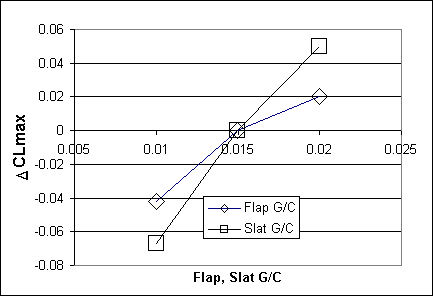
CFD Challenge – Gap Sensitivities
Currently, optimization of leading and trailing edge devices (deflection, gap, and overlap) requires lengthy and expensive wind tunnel testing. The capability to predict increments in lift and drag due to changes in slat and flap gap and overlap could significantly impact high lift system test costs and design cycle time.
The full-span and part-span landing configurations were tested over a range of deflection angles and gaps. Lift is typically least sensitive to flap overlap; due to test time constraints, overlap sensitivities were not investigated in either entry.
Increments in CLmax due to variations in flap and slat gap are shown in the figure below. Increments are taken relative to the baseline configuration (Config 1), with slat and flap gaps of 0.015c. CLmax increases with increasing gap for both, with slat gap sensitivities greater than flap gap sensitivities. The increasing lift with increasing gap suggest that boundary layer confluency is the limiting factor.

Increment in CLmax due to variations in flap and slat gap. Full-span landing flaps configuration, Re=8.8x106
return to Data Archive home page
Page Curator and NASA Official Responsible for Content
Judith A. Hannon
Last Updated
August 5, 2011